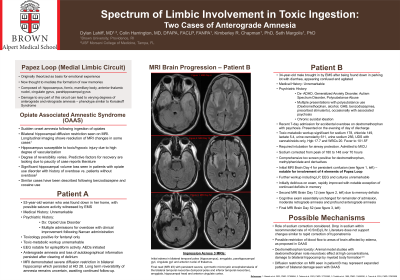Substance Use and Related Disorders
(173) Spectrum of Limbic Involvement in Toxic Ingestion: Two Cases of Anterograde Amnesia


DYLAN LAHIFF, MD
Consult Liaison Fellow, Brown University
Brown University
Fairfax, Virginia
Colin J. Harrington, Colin J Harrington MD, DFAPA, FACLP, FANPA
Director, CL Psychiatry, CNS-Psychiatry Clerkship and CLP Fellowship
Alpert Medical School of Brown University
Barrington, Rhode Island- KC
Kimberly R. Chapman, PhD
Clinical Neuropsychologist
Lifespan
Rumford, Rhode Island - SM
Seth A. Margolis, PhD
Assistant Professor
Brown University
Providence, Rhode Island
Presenting Author(s)
Co-Author(s)
Background:
Papez Circuit is posited as an essential network active in the formation of new memories. Components of Papez Circuit include the hippocampus, fornix, mamillary body, anterior thalamic nucleus, cingulate and parahippocampal gyri. Damage to this circuit can cause anterograde and/or retrograde amnesia. Cases of sudden onset amnesia after opiate ingestion with bilateral hippocampal damage (Opiate Associated Amnestic Syndrome (OAAS)) have been reported, as well as similar cases following benzodiazepine and cocaine use.
Method:
Here we present two cases of new onset amnesia: one of OAAS with bilateral hippocampal injury after fentanyl ingestion and another with damage to additional elements of Papez Circuit following dextromethorphan overdose – suggesting the possibility of a broader spectrum of limbic involvement in toxic ingestion.
Results:
Patient A: 53-year-old woman who was found down in her home, with possible seizure activity witnessed by EMS. Toxicology was positive for fentanyl. Additional toxic-metabolic workup was unremarkable. EEG was notable for epileptiform activity and AEDs were initiated. After clearing of delirium, residual anterograde amnesia and loss of autobiographical information was noted. MRI demonstrated severe diffusion restriction in bilateral hippocampi which persisted at HD 28. Reversibility of amnesia remains uncertain, awaiting 1 year follow-up.
Patient B: 34-year-old male admitted after being found down. He was confused and agitated on arrival. Declining respiratory status resulted in intubation. Toxicology was positive for dextromethorphan and methylphenidate. Serum chemistries were notable for hypernatremia to 180 mEq/L. Additional metabolic-infectious evaluation was unremarkable. Following extubation, a steady improvement in cognition was observed with the notable exception of memory. Serial MRIs (day 4, day 12, day 52) demonstrated initial edema and subsequent diffusion restriction in multiple areas of Papez Circuit including the bilateral anterior medial temporal lobes (hippocampi), anterior nuclei of thalamus, and parahippocampal and cingulate gyri. Follow-up neurocognitive testing is planned.
Discussion:
Both patients presented with an acute onset encephalopathy (delirium) in the setting of substance use / intoxication and later developed severe and persistent memory dysfunction with involvement on imaging of elements of Papez Circuit. Literature on opiate, benzodiazepine, and cocaine use suggests a correlation between hippocampal damage and persistent amnesia via unclear mechanisms (Todaro, 2023) (Barash, 2023) (Huang 2021). Additional structures involved in memory may also be susceptible to toxic injury with other illicit substances by as yet unidentified mechanism.
Conclusion:
Amnesia due to injury to bilateral hippocampi and other elements of Papez Circuit is a risk of illicit drug use. Clinicians should carefully assess memory after resolution of delirium in patients with substance use disorders and intoxication.
References:
Barash, J. A., Schmahmann, J. D., Xie, Z., Lev, M. H., & El Fakhri, G. (2023). Longitudinal Imaging in a patient with opioid-associated amnestic syndrome. Cognitive and Behavioral Neurology, 36(3), 194–197.
Huang, Deborah, and Rimas V Lukas. “Complete Bilateral Hippocampal Diffusion Restriction and Reversible Amnesia Following Opiate, Cocaine, and Benzodiazepine Abuse.” Cureus, 12 Jan. 2021, https://doi.org/10.7759/cureus.12651.
Todaro, Dustin R, et al. “Hippocampal Volume Loss in Individuals with a History of Non‐Fatal Opioid Overdose.” Addiction Biology, vol. 28, no. 10, 20 Sept. 2023.
Presentation Eligibility: Not previously published or presented.
Diversity, Equity, and Inclusion: Racial disparities in both substance use, as well as substance use treatment have been well documented. Individuals from zip codes associated with lower socioeconomic status show elevated rates of prescription opiate overdose (Pear, Drug and Alcohol Dependence, 2018) and a lower percent of minorities with substance use treatment are properly linked to substance use care (Webb, Journal of Substance Abuse Treatment, 2021). Our presentation aims to highlight a potential outcome of non-fatal overdose that may be recognized by clinicians. We hope to increase awareness in order to properly link at risk populations with longitudinal care.

